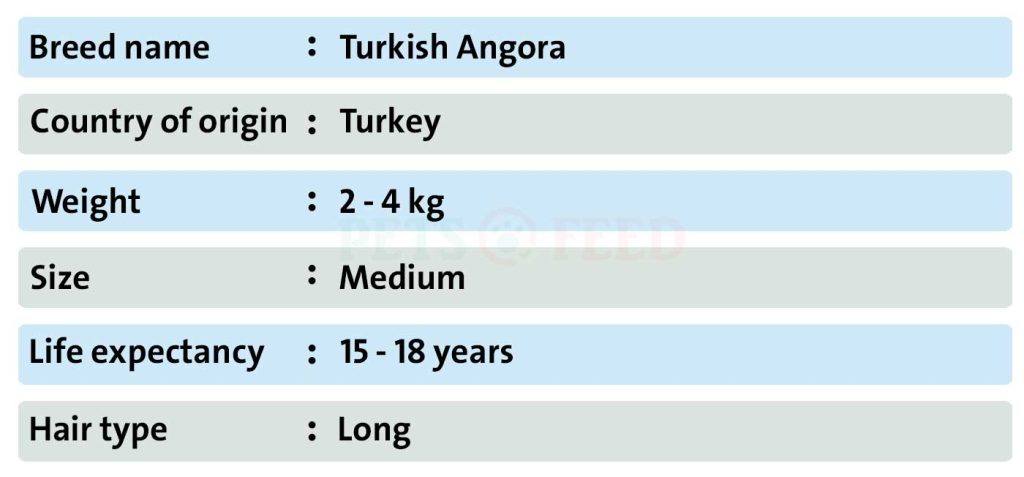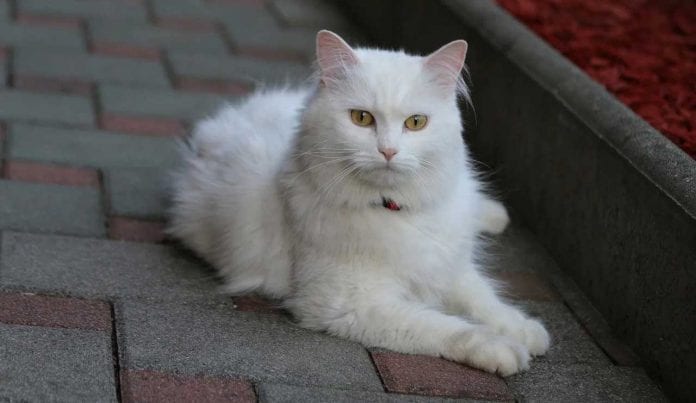One of the most majestic, delicate and elegant breeds in the feline world is undoubtedly the Turkish Angora cat. This breed is considered one of the oldest existing domestic cats, and they are also considered to be the first long-haired in history.

Turkish Angora photos
[foogallery id=”44345″]
Physical characteristics
First of all, the Turkish Angora is famous for its beautiful coat. Its long silky hairs sparkle in the sun, which gives the cat a particular charm. The length of the coat can be average or long. And on the neck of an angora, a necklace is still formed. The Turkish angora has a muscular body, long legs and rear legs, slightly higher than the front legs.
As for size, Turkish angora can be small or medium in size. Their weight is 2 to 4 kg.

Distinctive features
- The head of the Turkish angora is a flat corner. The head sizes are small to medium.
- The nose is long and straight, stacking towards the lobe;
- The ears are large and wide at the base, but end with sharp points. The ears are well stuffed inside, they seem transparent;
- The eyes are large, slightly oblique, expressive. Eye color can be anything. The color of the blue, gray, gold, red eyes is acceptable, discrepancy is also possible. Foulinologists do not find a relationship between the color of the eyes and the main color of the animal;
- The neck of the Angora cat is fine, graceful, the length of the neck is average.
- The description of the limbs is similar to the description of the legs of a gateway model – the legs are thin and endless, however, the rear legs are longer than the front legs. The legs are miniature, oval. Between the toe toes are long tufts of wool.
- The wool of Turkish angora has its own distinctive characteristics. Yes, they don’t have a sub-point. The coat is silky to the touch and very soft. Turkish women wear a shirt around their necks and oriental pants on the back legs. On the belly, the coat can be wavy, while on the tail, it is the longest and the most fluffy.
- The Turkish Angora kitten, according to the standard, cannot be chocolate, lilac and Himalayan.
Character and behavior
The character of the Turkish Angora is playful without being hyperactive. He knows how to be calm and quiet when the situation requires it and to activate himself during the moments of play. He likes to do all kinds of activities which develop his physique and his spirit, but he also likes the rest and the moments of tranquility like most.
He is a fairly sociable cat and enjoys spending time with his human family, even adopting canine behaviors such as following his owner throughout the house. However, you may not be sure you are dealing with children or strangers if you are not used and socialized since you are a baby Turkish Angora cat.
It should also be noted that these are docile animals, which learn quickly with their intelligence. In addition, they like prizes in the form of mimes or candies, making it a cat that can easily learn various tricks.
They also easily adapt to life anywhere as long as your family gives you the attention you need, especially when it comes to care and activity sessions. This cat will therefore be happy both in an apartment and in a large house with a garden.
Health
Turkish angora is a natural breed and is therefore considered generally healthy. However, there are hereditary diseases that you should be careful if you plan to have such a pet.
The diseases are as follows:
- Hypertrophic cardiomyopathy;
- Deafness.
Life expectancy
The life expectancy of the Turkish Angora is quite high and reaches 15-18 years.
Care
The Turkish angora has a very long and silky coat. However, it does not require much grooming because its coat is rarely tangled. Brush your cat twice a week is everything you need to keep the coat in perfect condition.
Turkish Angoras like the attention they receive, so the care process will be easy for the owner. You can water every two months, especially if your pet is white or light in color. It is also important to regularly check the ears and clean them if necessary.
Fun facts
- These cats love to brush their fur, even though they do not shed much. The pursuit of purity is at the genetic level.
- The longest coat of the breed is on the tail.
- In the last century, the popularity of white angora cats has increased greatly, and these were the results of the efforts of researchers who decided to develop this particular color. Earlier it was difficult to meet a white representative of the breed.
- It turns out that before Pietro della Vale’s Angora visit to Europe, all the indigenous local cats had short hair.
- There is a version that Potemkin brought the Turkish Angora cat to the court of the great Empress Catherine II. And the ruler warmly greeted the animal, as she loved them.
- Turkish Angora cats were painted on old postcards with congratulations on Angel Day.
- Previously, only the wealthiest people could afford the representatives of the breed. Such a kitty in the house was considered a symbol of material well-being.
- The CFA organization strictly monitors that these cats retain the features of their ancestors from Asia Minor.
- It is noteworthy that products containing mink oil and some products can make the animal’s coat yellow.
- Some organizations of connoisseurs of four-legged felines have long refused to recognize the Turkish Angora cat, because their crossing with the Persians led to the loss of the original characteristics of the variety.
- The price of an Turkish Angora kitten can be around $ 50. This is the most optimal cost given the prevalence and popularity of the breed that can be assigned. In nurseries, it varies depending on the class of the animal: pet, breed or show. The latter is the most expensive of all.
History of the breed
As its name suggests, the beautiful Turkish Angora comes from Turkey, where it has always been highly prized. There are records of these cats dating back to the 16th century. It was this breed of cats that contributed to the development of the Persian cat.
At the beginning of the 20th century, the Angora cat nearly died out, but since the breed was considered a national treasure in Turkey, a Turkish Angora breeding program was developed at Ankara Zoo.
During the 1950s, American servicemen spotted these beautiful cats during a visit to the Ankara Zoo, but it was not until the early 1960s that the zoo allowed the wife of an American colonel , Liesa Grant, to acquire a pair of cats which were then brought to the United States.
The Cat Fanciers Association did not register the breed until 1968 and accepted it into the Cat Championship in 1972. In 1979, the Angora breed was awarded champion status by the International Cat Association.


